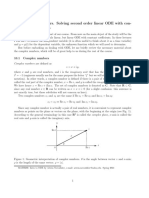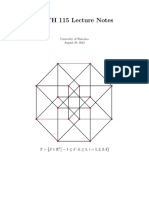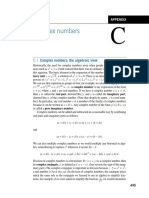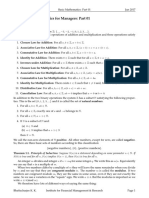Mathematical Prerequisites: 1.1 Operations On Complex Numbers
Uploaded by
Dennis Mads MakhandiaMathematical Prerequisites: 1.1 Operations On Complex Numbers
Uploaded by
Dennis Mads MakhandiaSignal Processing for Communications EPFL Winter Semester 2006/2007
Prof. Suhas Diggavi Handout # 4, Monday, 23 October 2006
Mathematical Prerequisites
1 Complex Numbers
Complex number is a number of the form a +bi, where a and b are real numbers, and i is the
imaginary unit, with the property i
2
= 1. The real number a is called the real part of the
complex number, and the real number b is the imaginary part. When the imaginary part b is
0, the complex number is just the real number a.
For example, 3 + 2i is a complex number, with real part 3 and imaginary part 2. If
z = a + bi, the real part (a) is denoted Re(z), and the imaginary part (b) is denoted Im(z).
Complex numbers can be added, subtracted, multiplied, and divided like real numbers,
but they have additional elegant properties. For example, real numbers alone do not provide a
solution for every polynomial algebraic equation with real coecients, while complex numbers
do (the fundamental theorem of algebra).
In some elds (in particular, electrical engineering and electronics, where i is a symbol for
current), complex numbers are written as a + bj.
1.1 Operations on Complex Numbers
The set of all complex numbers is usually denoted as C. The additions, substractions and
multiplications of complex numbers follow the associative, commutative and distributive laws
of algebra. Combining the latter properties with the equation i
2
= 1, it is easy to see that:
(a + bi) + (c + di) = (a + c) + (b + d)i (1)
(a + bi) (c + di) = (a c) + (b d)i (2)
(a + bi)(c + di) = ac + bci + adi + bdi
2
= (ac bd) + (bc + ad)i (3)
1.2 The Complex Number Field
Formally, the complex numbers can be dened as ordered pairs of real numbers (a, b) together
with the operations:
(a, b) + (c, d) = (a + c, b + d) (4)
(a, b) (c, d) = (ac bd, bc + ad) (5)
So dened, the complex numbers form a eld, the complex number eld, denoted by C.
Since a complex number a + bi is uniquely specied by an ordered pair (a, b) of real
numbers, the complex numbers are in one-to-one correspondence with points on a plane,
called the complex plane.
We identify the real number a with the complex number (a, 0), and in this way the eld of
real numbers R becomes a subeld of C. The imaginary unit i is the complex number (0, 1).
In C, we have:
additive identity (zero): (0, 0)
multiplicative identity (one): (1, 0)
1
additive inverse of (a, b) : (a, b)
multiplicative inverse (reciprocal) of non-zero (a, b):
_
a
a
2
+b
2
,
b
a
2
+b
2
_
1.3 The Complex Plane
A complex number z = a+bi can be viewed as a point or a position vector on a two-dimensional
Cartesian coordinate system called the complex plane. The Cartesian coordinates of the
complex number are the real part a and the imaginary part b, while the polar coordinates are
r = |z|, called the absolute value or modulus, and = arg(z), called the complex argument
of z (mod-arg form). Together with Eulers formula we have (see gure 1)
z = a + bi = r(cos + i sin ) = re
i
(6)
Figure 1: Complex plane representation
It is easy to see that:
r = |z| =
_
a
2
+ b
2
(7)
tan =
b
a
(8)
cos =
e
i
+ e
i
2
(9)
sin =
e
i
e
i
2i
(10)
By simple trigonometric identities, we see that
r
1
e
i
1
r
2
e
i
2
= r
1
r
2
e
i(
1
+
2
)
(11)
2
and that
r
1
e
i
1
r
2
e
i
2
=
r
1
r
2
e
i(
1
2
)
. (12)
This gives you an easy way to calculate the powers and the roots of complex numbers. Pay
attention to the fact that re
i
= re
i(+2k)
, k Z, so (re
i
)
1/N
= r
1/N
e
i(+2k)/N
,k =
0, 1, ..., N 1.
Now the addition of two complex numbers is just the vector addition of two vectors, and
the multiplication with a xed complex number can be seen as a simultaneous rotation and
stretching.
Multiplication with i corresponds to a counter clockwise rotation by 90 degrees (/2 ra-
dians). The geometric content of the equation i
2
= 1 is that a sequence of two 90 degree
rotations results in a 180 degree ( radians) rotation. Even the fact (-1) (-1) = +1 from
arithmetic can be understood geometrically as the combination of two 180 degree turns.
1.4 Absolute Value, Conjugation and Distance
One can check readily that the absolute value has three important properties:
|z| = 0 if and only if z = 0 (13)
|z + w| |z| + |w| (triangle inequality) (14)
|zw| = |z| |w| (15)
for all complex numbers z and w. It then follows, for example, that |1| = 1 and |z/w| =
|z|/|w| . By dening the distance function d(z, w) = |z w| we turn the complex numbers
into a metric space and we can therefore talk about limits and continuity. The addition,
subtraction, multiplication and division of complex numbers are then continuous operations.
Unless anything else is said, this is always the metric being used on the complex numbers.
The complex conjugate of the complex number z = a + ib is dened to be a ib, written
as z or z
. z is the reection of z about the real axis. The following can be checked:
z + w = z + w (16)
zw = z w (17)
(z/w) = z/ w (18)
z = z (19)
z = z if and only if z is real (20)
|z| = | z| (21)
|z|
2
= z z (22)
z
1
= z|z|
2
if z is non zero. (23)
The latter formula is the method of choice to compute the inverse of a complex number if it
is given in rectangular coordinates.
That conjugation commutes with all the algebraic operations (and many functions; e.g.
sin z = sin z) is rooted in the ambiguity in choice of i (-1 has two square roots).
2 Summations
Let f be a function whose domain includes the integers from n through m. We dene
m
i=n
f(i) = f(n) + f(n + 1) + ... + f(m) (24)
3
We call i the index of summation,n is the lower limit of summation, and m is the upper limit
of summation. One can show that:
n
k=1
c = c + c + ... + c = cn (25)
n
k=1
k = 1 + 2 + ... + n =
n(n + 1)
2
(26)
n
k=1
k
2
= 1 + 4 + ... + n
2
=
n(n + 1)(2n + 1)
6
(27)
(28)
Another well-known result is the following:
S
n
=
n
k=0
r
k
= 1 + r + r
2
+ ... + r
n
=
_
1r
n+1
1r
if r = 1
n + 1 else
(29)
Note that when r < 1:
lim
n+
S
n
=
1
1 r
(30)
Additionally, be very cautious when taking squares of summations:
_
m
i=n
f(i)
_
2
=
_
m
l=n
f(l)
__
m
k=n
f(k)
_
=
m
l=n
m
k=n
f(l)f(k) (31)
Finally, lets S
N
=
N
n=1
a
n
and S = lim
N+
S
N
. If the sequence of partial sums is
divergent (i.e. either the limit does not exist or is innite) then we call the series divergent.
if |S| = c < , we call the series convergent and we call S the sum or value of the series.
The Cauchy convergence criterion states that a series
n=1
a
n
converges if and only if the
sequence of partial sums is a Cauchy sequence. This means that for every > 0, there is a
positive integer N such that for all n m N we have:
k=m
a
k
< (32)
which is equivalent to
lim
n
m
n+m
k=n
a
k
= 0 (33)
3 Integration
Besides being comfortable with the basic properties of integrals and methods for integra-
tion (e.g. substitution, integration by parts) it is important to know the denition and basic
properties of the convolution integral.
The convolution between two functions f and g, both with domain R, is itself a function,
lets call it h, and is dened by
h(x) := f(x) g(x) =
_
R
f(y)g(x y)dy.
The following properties are easy to show:
f(x) g(x) = g(x) f(x).
f(x) (g(x) h(x)) = (f(x) g(x)) h(x).
f(x) ( g(x) + h(x)) = f(x) g(x) + f(x) h(x).
4
4 Linear Algebra
4.1 Matrices
Let A be a matrix with n rows and m colums of complex entries. That is, we have
A :=
_
_
A
1,1
A
1,2
. . . A
1,m
A
2,1
A
2,2
. . . A
2,m
.
.
.
.
.
.
.
.
.
.
.
.
A
n,1
A
n,2
. . . A
n,m
_
_
,
A
i,j
C.
One of the basic operations on A is taking the transpose, denoted by A
T
and dened as
_
A
T
_
i,j
= A
j,i
, i = 1, . . . , n, j = 1, . . . , m. More explicitely we have
A
T
=
_
_
A
1,1
A
2,1
. . . A
n,1
A
1,2
A
2,2
. . . A
n,2
.
.
.
.
.
.
.
.
.
.
.
.
A
1,m
A
2,m
. . . A
m,n
_
_
.
The conjugate transpose of A, denoted by A
, is dened as (A
)
i,j
= A
j,i
. Besides taking the
transpose of A we take the complex conjugate of each element. Note that A
is also known
as the Hermitian of A.
Based on the above operations we dene symmetric and Hermitian matrices. A real matrix
A is symmetric if A
T
= A, a (complex) matrix is Hermitian if A
= A.
The matrix A can be right multiplied with a m by p matrix, say B, resulting in a n by p
matrix. Remember that matrix multiplication is dened by (AB)
i,j
=
m
k=1
A
i,k
B
k,j
. Note
that matrix multiplication is not commutative, i.e. AB = BA (assuming n = m).
4.2 Vectors
Let c and d be length n resp. m vectors, i.e. c = [c
1
, c
2
, . . . , c
n
] and d = [d
1
, d
2
, . . . , d
m
]. We
will usually assume that vectors are column vectors. This allows us to right multiply our
matrix A with vector d. The result Ad is a length n vector. Similarly b
T
A gives a length m
row vector.
The inner product between two n length vectors a and b is dened by
a, b :=
n
i=1
a
i
b
i
= a
T
b.
Note that matrix multiplication is nothing more than taking inner products between rows and
columns of the two matrices. The most common way to dene the norm of a vector is through
the inner product. This gives that the norm of x, x
2
is dened as
x
2
= x, x
1/2
.
A very useful relation is the Cauchy-Schwartz inequality, which states that
| x, y | x
2
y
2
.
4.3 Determinants
One of the most used properties of a matrix is its determinant. The determinant of a 2 by 2
matrix
A =
_
a b
c d
_
5
is given by
det(A) = ad bc.
In general for a square n by n matrix A we have, for any row i = 1, . . . , n
det(A) =
n
j=1
A
i,j
(1)
i+j
det
_
A
\(i,j)
_
,
where A
\(i,j)
is the resulting matrix after removing row i and column j from matrix A. We
can also expand along any column j = 1, . . . , m, which gives us
det(A) =
n
i=1
A
i,j
(1)
i+j
det
_
A
\(i,j)
_
.
An important result to keep in mind is that
a matrix is invertible if and only if its determinant is not equal to zero.
Finally, we note the following basic relations:
det(AB) = det(A) det(B).
det
_
A
1
_
= det (A)
1
.
det(A
) = det(A)
.
4.4 Eigenvalues and Eigenvectors
The eigenvalues of a matrix A are the solutions for in the equation
det(A I) = 0,
which is called the characteristic equation. Given that
is an eigenvalue of A, we call the
vector x for which
Ax =
x.
the eigenvector corresponding to
.
One can verify that the eigenvalues of A and A
are the same. The eigenvectors for a
matrix and its conjugate transpose are however dierent.
6
You might also like
- Living The Cross Centered Life by CJ Ma Haney100% (1)Living The Cross Centered Life by CJ Ma Haney2 pages
- Very Short Review About Complex AnalysisNo ratings yetVery Short Review About Complex Analysis45 pages
- Complexanalysis 1 Complex Numbers and DerivativesNo ratings yetComplexanalysis 1 Complex Numbers and Derivatives19 pages
- 5 Complex Numbers and Functions: 5.1 Arithmetic in CNo ratings yet5 Complex Numbers and Functions: 5.1 Arithmetic in C27 pages
- Part IA - Vectors and Matrices: Based On Lectures by N. PeakeNo ratings yetPart IA - Vectors and Matrices: Based On Lectures by N. Peake50 pages
- Complex Analysis A Short Guide: Hameer Abbasi Thursday, 8 December, 2011No ratings yetComplex Analysis A Short Guide: Hameer Abbasi Thursday, 8 December, 201118 pages
- Complex Numbers and Polynomials: Mats BodinNo ratings yetComplex Numbers and Polynomials: Mats Bodin43 pages
- Tarun Kumar Bandyopadhyay, Department of Mathematics: (1) Classical Algebra-S.K.Mapa67% (3)Tarun Kumar Bandyopadhyay, Department of Mathematics: (1) Classical Algebra-S.K.Mapa31 pages
- Mathematics Surveying and TransportationNo ratings yetMathematics Surveying and Transportation15 pages
- Oundation Mathematics Group TEN Summarize OF Overall Syllabus100% (1)Oundation Mathematics Group TEN Summarize OF Overall Syllabus114 pages
- Appendix C Complex Number 2021 A Modern Introduction To Differential EquatNo ratings yetAppendix C Complex Number 2021 A Modern Introduction To Differential Equat4 pages
- Mathematics & Statistics For Managers: Part 01 1 Number SystemNo ratings yetMathematics & Statistics For Managers: Part 01 1 Number System6 pages
- Lecture 1 - Complex Numbers 1 The Field of Complex Numbers: 1.1 Arithmetic OperationsNo ratings yetLecture 1 - Complex Numbers 1 The Field of Complex Numbers: 1.1 Arithmetic Operations6 pages
- +2 ELEMENTS OF MATHMATICS PART-I Pages 1-50No ratings yet+2 ELEMENTS OF MATHMATICS PART-I Pages 1-5017 pages
- Engineering mathematics Subject Lecture: ثراح يلع Stage: Second - A Subject: Complex Numbers لهنم رامع دمحمNo ratings yetEngineering mathematics Subject Lecture: ثراح يلع Stage: Second - A Subject: Complex Numbers لهنم رامع دمحم17 pages
- Elementary Properties of Complex NumbersNo ratings yetElementary Properties of Complex Numbers16 pages
- Theology How Do We Determine The 'Messianic' Material in The Psalms?100% (1)Theology How Do We Determine The 'Messianic' Material in The Psalms?1 page
- The Clock of The Long Now: by Shari CohenNo ratings yetThe Clock of The Long Now: by Shari Cohen3 pages
- BS 476-3-1975 - Fire Test On Building Materials & Structures - Part 3 - External Fire Exposure Roof TestsNo ratings yetBS 476-3-1975 - Fire Test On Building Materials & Structures - Part 3 - External Fire Exposure Roof Tests14 pages
- 2024 Stanford cs25 Guest Lecture Jason WeiNo ratings yet2024 Stanford cs25 Guest Lecture Jason Wei20 pages
- Updated Course Material 5 in Math 2 For 2nd Semester 2021 2022 For DistributionNo ratings yetUpdated Course Material 5 in Math 2 For 2nd Semester 2021 2022 For Distribution14 pages
- Revising Algebra Skills: Jackie NicholasNo ratings yetRevising Algebra Skills: Jackie Nicholas12 pages
- La Danse, A Film by Frederick Wiseman 2009No ratings yetLa Danse, A Film by Frederick Wiseman 20095 pages
- Million-Day Gregorian-Julian Calendar - Notes100% (1)Million-Day Gregorian-Julian Calendar - Notes10 pages
- Ash Handling System: in A 210 M.W Boiler, The Coal Consumption Is 3,500 M.T S Per Day The Ash Content Is 1,400 M.T SNo ratings yetAsh Handling System: in A 210 M.W Boiler, The Coal Consumption Is 3,500 M.T S Per Day The Ash Content Is 1,400 M.T S22 pages
- [Ebooks PDF] download The Event Manager s Bible How to Plan and Deliver an Event 2nd Edition Des Conway full chapters100% (8)[Ebooks PDF] download The Event Manager s Bible How to Plan and Deliver an Event 2nd Edition Des Conway full chapters85 pages
- Netter s Concise Radiologic Anatomy Netter Basic Science 1st Edition Edward Weber Do 2024 scribd downloadNo ratings yetNetter s Concise Radiologic Anatomy Netter Basic Science 1st Edition Edward Weber Do 2024 scribd download51 pages
- Physical Education and Health 12: 3 Quarter Week 3No ratings yetPhysical Education and Health 12: 3 Quarter Week 36 pages
- Applications of Thin Airfoil Theory - Part 1No ratings yetApplications of Thin Airfoil Theory - Part 128 pages
- 5 Complex Numbers and Functions: 5.1 Arithmetic in C5 Complex Numbers and Functions: 5.1 Arithmetic in C
- Part IA - Vectors and Matrices: Based On Lectures by N. PeakePart IA - Vectors and Matrices: Based On Lectures by N. Peake
- Complex Analysis A Short Guide: Hameer Abbasi Thursday, 8 December, 2011Complex Analysis A Short Guide: Hameer Abbasi Thursday, 8 December, 2011
- Tarun Kumar Bandyopadhyay, Department of Mathematics: (1) Classical Algebra-S.K.MapaTarun Kumar Bandyopadhyay, Department of Mathematics: (1) Classical Algebra-S.K.Mapa
- Oundation Mathematics Group TEN Summarize OF Overall SyllabusOundation Mathematics Group TEN Summarize OF Overall Syllabus
- Appendix C Complex Number 2021 A Modern Introduction To Differential EquatAppendix C Complex Number 2021 A Modern Introduction To Differential Equat
- Mathematics & Statistics For Managers: Part 01 1 Number SystemMathematics & Statistics For Managers: Part 01 1 Number System
- Lecture 1 - Complex Numbers 1 The Field of Complex Numbers: 1.1 Arithmetic OperationsLecture 1 - Complex Numbers 1 The Field of Complex Numbers: 1.1 Arithmetic Operations
- Engineering mathematics Subject Lecture: ثراح يلع Stage: Second - A Subject: Complex Numbers لهنم رامع دمحمEngineering mathematics Subject Lecture: ثراح يلع Stage: Second - A Subject: Complex Numbers لهنم رامع دمحم
- A-level Maths Revision: Cheeky Revision ShortcutsFrom EverandA-level Maths Revision: Cheeky Revision Shortcuts
- Theology How Do We Determine The 'Messianic' Material in The Psalms?Theology How Do We Determine The 'Messianic' Material in The Psalms?
- BS 476-3-1975 - Fire Test On Building Materials & Structures - Part 3 - External Fire Exposure Roof TestsBS 476-3-1975 - Fire Test On Building Materials & Structures - Part 3 - External Fire Exposure Roof Tests
- Updated Course Material 5 in Math 2 For 2nd Semester 2021 2022 For DistributionUpdated Course Material 5 in Math 2 For 2nd Semester 2021 2022 For Distribution
- Ash Handling System: in A 210 M.W Boiler, The Coal Consumption Is 3,500 M.T S Per Day The Ash Content Is 1,400 M.T SAsh Handling System: in A 210 M.W Boiler, The Coal Consumption Is 3,500 M.T S Per Day The Ash Content Is 1,400 M.T S
- [Ebooks PDF] download The Event Manager s Bible How to Plan and Deliver an Event 2nd Edition Des Conway full chapters[Ebooks PDF] download The Event Manager s Bible How to Plan and Deliver an Event 2nd Edition Des Conway full chapters
- Netter s Concise Radiologic Anatomy Netter Basic Science 1st Edition Edward Weber Do 2024 scribd downloadNetter s Concise Radiologic Anatomy Netter Basic Science 1st Edition Edward Weber Do 2024 scribd download
- Physical Education and Health 12: 3 Quarter Week 3Physical Education and Health 12: 3 Quarter Week 3











































































































